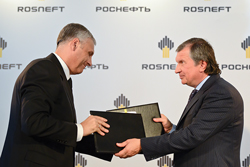|
Igor Sechin’s star is rising, indeed. Rosneft’s chairman is now one of the most potent, influential men in Russia after President Putin. The gigantic deal that led to Rosneft’s absorption of TNK-BP made this company one of the most important firms—if not the company—in Russia’s oil sector. So, after the appointment of Sechin to the board of directors of RAO-EES, who and what could stop the man?
On the other hand, at the beginning of July, Dmitry Medvedev, the former president turned prime minister, sacked Alexander Popov, the head of Rosnedra, an agency responsible for granting licenses to develop natural resources. Popov worked with Sechin for years, but this is most probably the last bite of a dying tiger, as Medvedev’s own position is not well-assured. Most of his power has been transferred to the presidential administration, and he has lost most of his allies since last winter. The probability that he would leave, or be dismissed by next fall, seems pretty high now. Sechin is thus, and without doubt, the most influential of all Putin’s allies and quite certainly Russia’s new rising star. Sechin has been pivotal in Rosneft’s transformation into not just one of the biggest oil companies, but into a major player in the whole energy market. Through its association with BP, Rosneft gained access to E&P technology, not just in the oil sector, but as regards associated gas, too. Rosneft also gained a very important technology inflow, which would allow it to be a leader in the shale sector, when Russian authorities decide that the time has come for such activity. Recent developments in the electric power sector, certified by Sechin’s nomination, first to the board of directors and then as president of the board at the annual assembly of shareholders on June 25, are but one example of the diversification strategy he has implemented. During this same time period, he has also prepared Rosneft to become an important competitor in the gas sector, and then to become a supplier to RAO. This is proof that Gazprom, the traditional Russian gas monster, is progressively losing its influence. And, once again, one could correlate this loss to the diminishing status of Dmitry Medvedev. Sechin has understood, too, which responsibilities belong to him. On July 16, while President Putin was closely monitoring the most important exercise ever launched by the Russian armed forces (and in close cooperation with China), he promised to invest $30 billion in Eastern Siberia and Russia’s Far East. By doing so, he made Rosneft one of the most important actors in Russian territorial development policy. Quite certainly, this announcement was timed to correspond with negotiations on the tax burden weighing on Russian oil producers. Also quite certainly, this was timed to fit with Putin’s plans to develop the Far East. Nevertheless, Sechin took an important option in a decisively important field. It is also well known that he has, for years, advocated a so-called “Chinese course” for Russia and has strongly favored the Chinese model. This gives even greater weight to the promise of investing $30 billion, a decision that appears to reflect a change in Russian strategy. Would then, Sechin become Russia’s most important man after Putin, mimicking the former Duc de Rohan motto, “King I couldn’t, Duke I wouldn’t, I am Rohan.” Sechin’s path to supreme power is still undecided. Maybe, he would prefer to stay in the shadows. Or maybe, he would prefer a more tangible position as prime minister, replacing Medvedev and entering the race for Putin’s succession. However, his current status depends on two things. The first item is Rosneft’s and, more generally, the oil sector’s contribution to Russian modernization and development. Modernization is important to Putin, and the Russian political elite, who are looking at the U.S. and China with a mix of admiration, envy and resentment. Could Rosneft become, both directly (by using advanced E&P technologies) and indirectly (by fostering a large demand in other industries for advanced technologies), one of Russia’s engines of innovation and development? The second item is more subtle. Sechin’s ascent must be compatible with others’ ambitions. He would be well-advised to remember what happened to Nicolas Fouquet, King Louis XIV’s surintendant aux finances (equivalent to Minister of Finance and certainly the most powerful man after the king at the beginning of Louis XIV’s reign). Fouquet was a man, whose personal motto was “Where will I ascend?” His meteoric rise was succeeded by a dramatic fall, as he attracted the jealousy of too many people, including the king. Sechin’s future depends on not antagonizing people. Sechin’s path to power is plagued with uncertainties and enemies, but few doubt that he will become an influential leader, and, maybe, a Putin successor. Putin failed, in his previous attempt, to find a successor. He cannot fail the next time, in 2018. After trying different people from the administration, Putin could then choose someone with a good track record, both in the administration and in business. Sechin appears to be a quite viable candidate. |

- Mixed outlook for activity on the UK Continental Shelf (December 2023)
- First Oil: Sorting through the muddled mess (November 2022)
- First Oil: Electricity problems reflect poor energy/resource policy (August 2022)
- First Oil: A tale of two “windfalls” (June 2022)
- The ESG perspective: A day without oil? (April 2022)
- Executive viewpoint: Texas oil and gas can save Europe—again (April 2022)
- Applying ultra-deep LWD resistivity technology successfully in a SAGD operation (May 2019)
- Adoption of wireless intelligent completions advances (May 2019)
- Majors double down as takeaway crunch eases (April 2019)
- What’s new in well logging and formation evaluation (April 2019)
- Qualification of a 20,000-psi subsea BOP: A collaborative approach (February 2019)
- ConocoPhillips’ Greg Leveille sees rapid trajectory of technical advancement continuing (February 2019)




